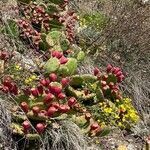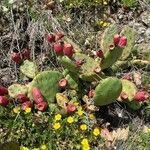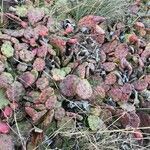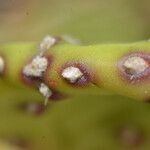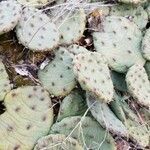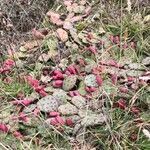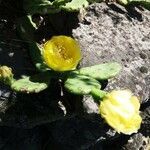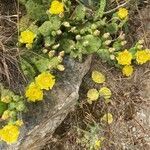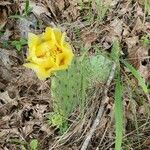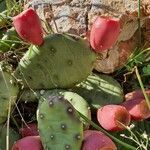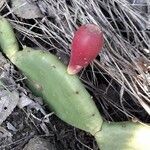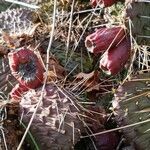Shrubs, forming clumps or often prostrate, usually only 1 or 2 stem segments tall, to 0.5 m (except in Florida where they may be erect and reach to 2+ m with short trunk), flattened to obovoid, sometimes from tuberlike rootstocks. Stem segments not disarticulating, dark or bright shiny green, wrinkling when stressed, circular to broadly oblong to obovate, 5-17.5 × 4-12 cm, fleshy, usually tuberculate, glabrous; areoles 4-6 per diagonal row across midstem segment, oval to circular, 2-4 mm diam., not raised, sometimes somewhat sunken; wool tan to brown. Spines often absent or 1-2(-3) per areole, spreading, whitish to brownish, terete, straight, and usually stout, 25-60 mm; occasionally also 1 deflexed spine present. Glochids in dense crescent of adaxial edge of areole and in dense tuft overtopping crescent in age, yellow to red-brown, to 4 mm. Flowers: inner tepals pale to bright yellow throughout, 20-30 mm diam.; filaments yellow to orange; anthers pale yellow to cream; style and stigma lobes white. Fruits greenish, tardily becoming apricot to brownish red, elongate, 30-50 × 12-20 mm, fleshy, tapering at base; pulp green and sour, becoming reddish and sweet under ideal conditions; areoles 10-18. Seeds tan, 3.5-4.5 mm diam., thickish; girdle protruding to 1 mm.
Prostrate or spreading, forming large mats; roots mostly fibrous, only seldom tuberous-thickened; joints of the stem flattened, oblong to suborbicular, 4–12 cm at maturity; areoles commonly 10–25 mm apart, spineless, or some of them with 1, rarely 2 spines 1.5–3 cm; fls 4–8 cm wide, yellow, often with a red center; outer sep subulate to lanceolate; fr red or purple, 2.5–5 cm, edible; seeds discoid, with an indurate, regular margin. On rocks, shores, sand-dunes, or sandy prairies; e. Mass. to s. Ont. and s. Minn., s. to Fla. and e. Tex. June, July. (O. calcicola; O. compressa; O. opuntia; O. pollardii; O. rafinesquei; O. vulgaris, misapplied)
A cactus. It forms spreading clumps. They are about 30 cm high. The stem segments are fleshy and dull green. They are slightly spiny. They are 4-10 cm long and 4-6 cm wide. The flowers are yellow and 4-6 cm long and 4-6 cm wide. The fruit is dark red or purple. They are 1.5-4 cm long by 2-3 cm wide.
